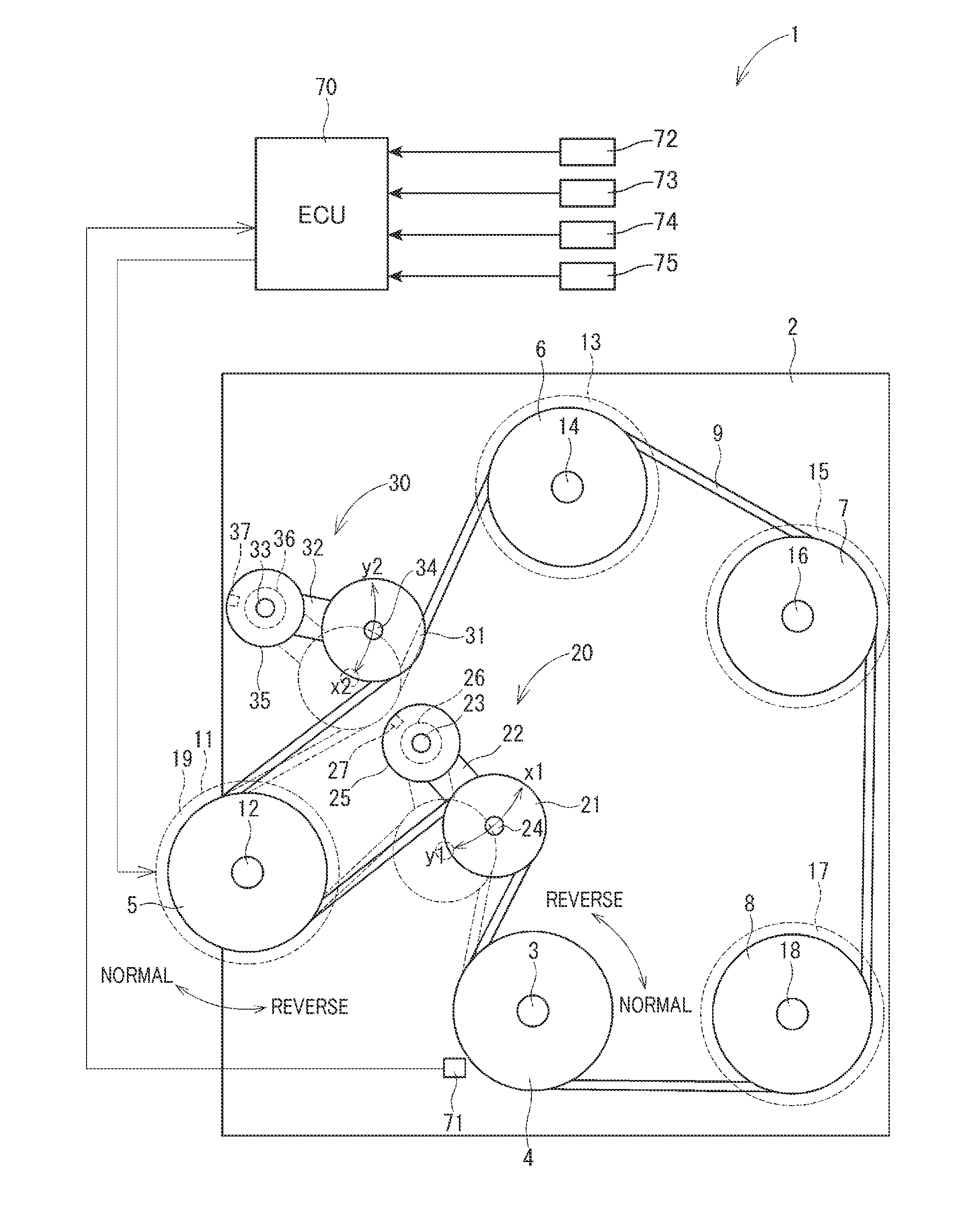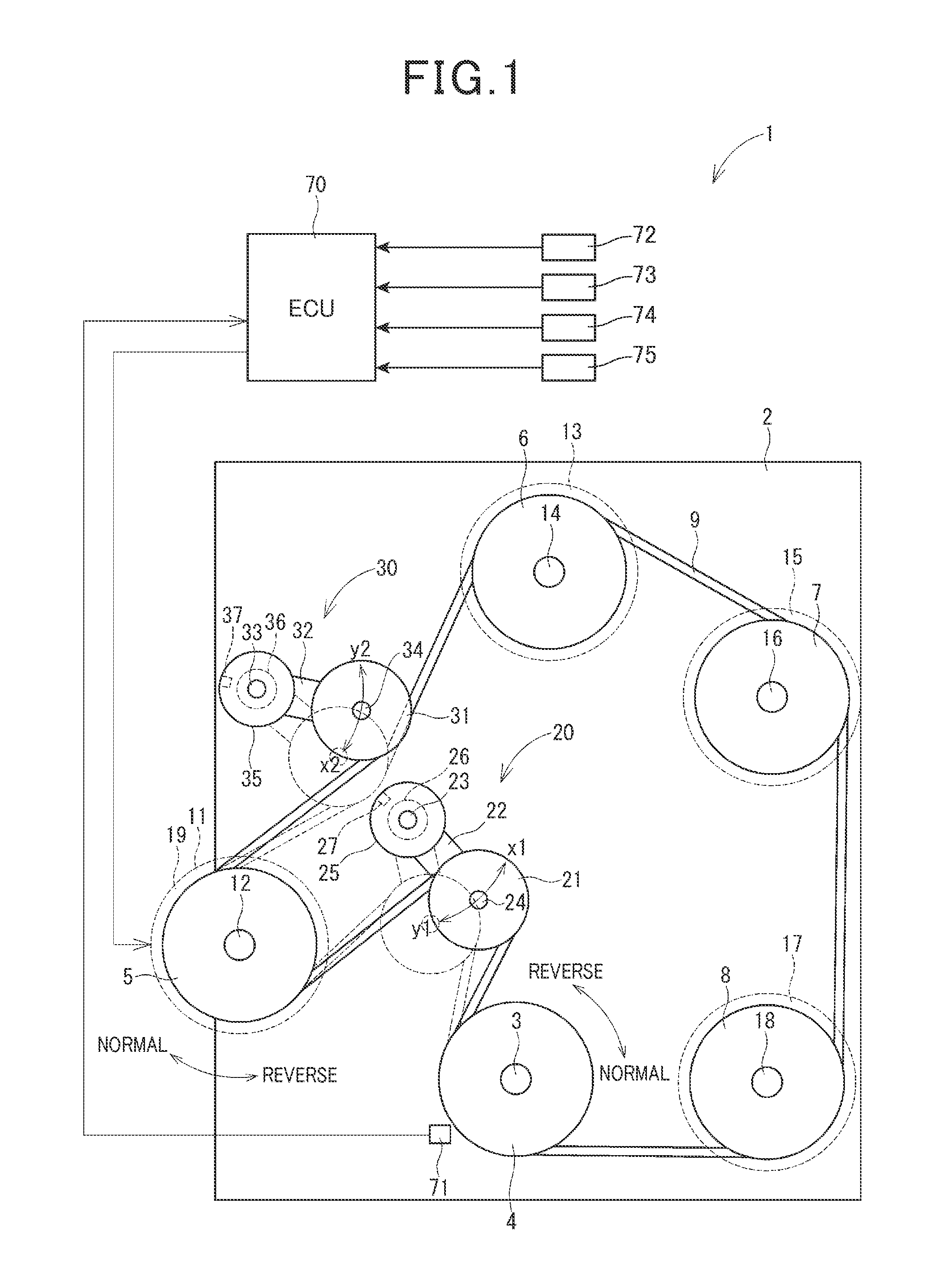Structure of power transmission apparatus
a technology of power transmission apparatus and structure, which is applied in the direction of engine starters, machines/engines, and gears, etc., can solve the problems of increasing the production cost of the power transmission system, time lag in cranking the internal combustion engine, and the tension of the endless transmitting member is great, so as to reduce the amount of time, avoid the effect of increasing the degree of tension, and minimize the loosening of the bel
- Summary
- Abstract
- Description
- Claims
- Application Information
AI Technical Summary
Benefits of technology
Problems solved by technology
Method used
Image
Examples
first embodiment
[0037]FIG. 1 illustrates a power transmission system 1 according to the first embodiment. The power transmission system 1, as referred to herein, is installed in an automotive vehicle equipped with an internal combustion engine 2 and works to transmit output power (i.e., torque), as produced by the engine 2, to a given accessory 11 and other accessories 13, 15, and 17 mounted in the vehicle. The accessories 11, 13, 15, and 17, as referred to herein, are auxiliary electric or mechanical devices which are supplied with or transmit power or torque from or to the internal combustion engine 2. The given accessory 11 will also be referred to below as a first auxiliary device. The accessories 13, 15, and 17 will also be referred to below as second auxiliary devices.
[0038]The power transmission system 1 is, as clearly illustrated in FIG. 1, disposed near the engine 2. The power transmission system 1 includes a driving pulley 4, a given accessory pulley 5, accessory pulleys 6, 7, and 8, a be...
second embodiment
[0084]FIG. 4 illustrates the power transmission system 1 according to the second embodiment which is different only in structure of the first auto-tensioner 20 and the second auto-tensioner 30 from the first embodiment.
[0085]The first auto-tensioner 20 has the arms 22 whose end is borne by the shaft 12, so that the arm 22 is movable or swingable about the shaft 12 relative to the engine 2.
[0086]Similarly, the second auto-tensioner 30 has the arm 32 whose end is borne by the shaft 12, so that the arm 32 is movable or swingable about the shaft 12 relative to the engine 2.
[0087]The power transmission system 1 also includes a spring 28 which is connected at an end thereof to the shaft 24 of the first auto-tensioner 20 and at the other end to the shaft 34 of the second auto-tensioner 30. The spring 28 works as a biasing mechanism to urge the shafts 24 and 34 in a direction in which the shafts 24 and 34 approach each other. Specifically, the first tensioner pulley 21 and the second tensio...
third embodiment
[0091]FIG. 5 illustrates the power transmission system 1 according to the third embodiment which is different only in structure of the first auto-tensioner 20 from the first embodiment.
[0092]Specifically, the base 25 of the first auto-tensioner 20 is different in location of installation thereof from the first embodiment. Additionally, the first auto-tensioner 20 does not have the stopper 27.
[0093]In operation of the power transmissions system 1 of this embodiment, the ECU 70 actuates the given accessory 11 in the motor mode when the engine 2 is being stopped, so that the degree of tension of the belt 9 increases. This causes the arm 22 and the first tensioner pulley 21 to be swung in the direction y1 against the pressure, as produced by the spring 26, until it reaches the given position. When a direction in which force F, as exerted by the belt 9 on the first tensioner pulley 21 (i.e., the shaft 24), coincides with the length (i.e., the longitudinal center line) of the arm 22, the ...
PUM
 Login to View More
Login to View More Abstract
Description
Claims
Application Information
 Login to View More
Login to View More - R&D
- Intellectual Property
- Life Sciences
- Materials
- Tech Scout
- Unparalleled Data Quality
- Higher Quality Content
- 60% Fewer Hallucinations
Browse by: Latest US Patents, China's latest patents, Technical Efficacy Thesaurus, Application Domain, Technology Topic, Popular Technical Reports.
© 2025 PatSnap. All rights reserved.Legal|Privacy policy|Modern Slavery Act Transparency Statement|Sitemap|About US| Contact US: help@patsnap.com



